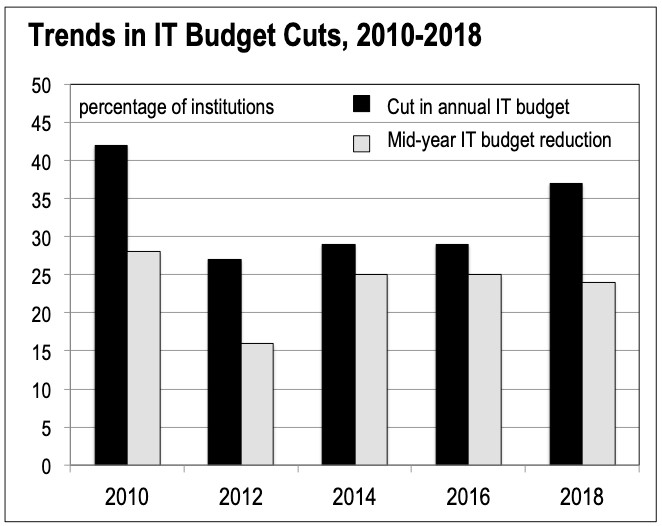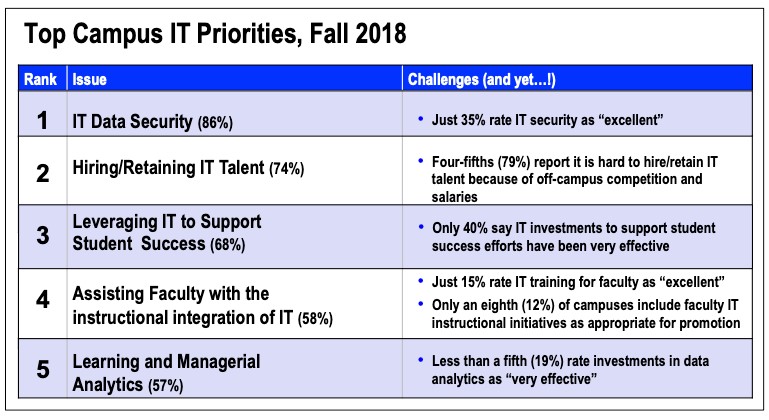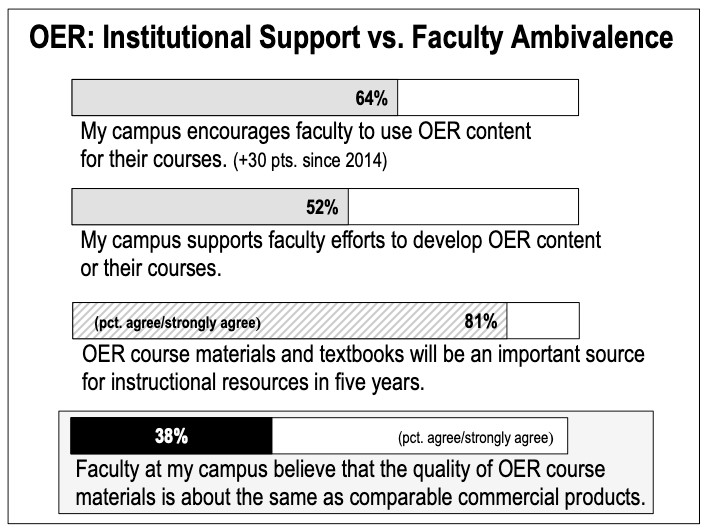You have /5 articles left.
Sign up for a free account or log in.

Istockphoto.com/kitzcorner
Lean information technology budgets are making it difficult for colleges to hang on to talented employees, the latest Campus Computing Survey reveals.
More than two-thirds of IT leaders surveyed this year, from 242 two- and four-year public and private nonprofit colleges and universities across the U.S., reported that their campus IT budgets had still not recovered from the 2008 recession -- when many institutions experienced sweeping cuts.
“Annual IT cuts and midyear budget reductions have become all too common for many institutions over the past decade,” said Kenneth C. Green, founding director of the Campus Computing Project, which conducts the survey.
“These recurring cuts come despite growing demand and expanding need for campus IT resources and services to support instruction and campus operations, and also increased IT security challenges,” said Green. The results of the survey will be presented today at the Educause conference in Denver.

Retaining talented IT staff has become a real challenge for IT leaders, the survey found. More than four-fifths (79 percent) of survey participants said that their campus had “a difficult time retaining IT talent because salaries and benefits are not competitive with off-campus job opportunities.”
IT departments are also experiencing significant “organizational churn,” said Green. Just under half (45 percent) of survey respondents said that their department had been reorganized in the past two years. Of the departments that recently reorganized, a third (31 percent) said they expected to do so again in the next two years.
Budget cuts could be causing IT units to consolidate, but Green notes that IT departments have had significant reorganization activity in both good and difficult economic times -- suggesting that this instability may “almost be a structural aspect of life in campus IT units.”
Data security emerged as IT leaders' top concern, with just 35 percent rating their IT security as "excellent." Concerns about phishing and other data hacks mean that many institutions are regularly updating their cybersecurity plans, said Green. But 11 percent of institutions said they had not updated their cybersecurity plans in the past two years.
IT leaders' second biggest concern was hiring and retaining IT talent, followed by leveraging IT to support student success in third and assisting faculty with the instructional integration of IT in fourth place. These four issues have been among the top five IT priorities for the past several years, said Green. But this year there was a new addition to the top five -- learning and managerial analytics. Insights from big data are seen as increasingly important, said Green.
But campus investments in analytics are not meeting expectations. Less than a fifth of survey participants described their institution’s investments in data analysis and learning and managerial analytics over the past few years as “very effective.”

Despite 65 percent of campus IT leaders saying that assessing the effectiveness of IT investments is “very important,” relatively few campuses (16 percent) have a formal program in place to assess the impact of IT on learning outcomes. “Part of the challenge is that the academic initiatives are often programmatic or centered in academic departments,” said Green. “In too many circumstances the formal assessment of these initiatives may be an afterthought or unfunded expense.”
Green expressed concern that a significant number of respondents (31 percent) said their campus had not updated IT disaster-recovery plans in the last 24 months. Recent hurricanes and storms have shown that IT disaster recovery is an essential task, said Green, and not updating such plans regularly is risky. “This truly is an example of when, not if,” he said.
IT leaders reported rising institutional support for open educational resources at their institutions -- with 64 percent saying that their campus encourages faculty to use OER, up from 34 percent in 2014. A large number (81 percent) agreed that OER course materials and textbooks “will be an important source for instructional resources in five years.” However, only 38 percent reported that faculty at their campus believe the quality of OER content to be as good as comparable commercial products.

Artificial intelligence is of increasing interest to IT leaders, the survey found. Two-fifths of survey participants said that AI will play an important role in analytics in the coming years, up from 30 percent in 2017. Fewer participants (30 percent) agreed that AI would play an important role in instruction, up from 19 percent in 2017.
Generally, IT leaders had great faith in the potential for technology to improve instruction -- with 96 percent agreeing that adaptive learning technology has “great potential to improve learning outcomes” and 92 percent agreeing that digital course materials provide “a richer and more personalized experience than traditional print materials.” (Faculty members have a somewhat different take on this, as evident from Inside Higher Ed's 2018 Survey of Faculty Attitudes on Technology, also published today.)
But actual deployment of these technologies appears to be low. Only 17 percent said that general education courses at their institution use digital courseware, and just 8 percent said they used adaptive learning technologies.




